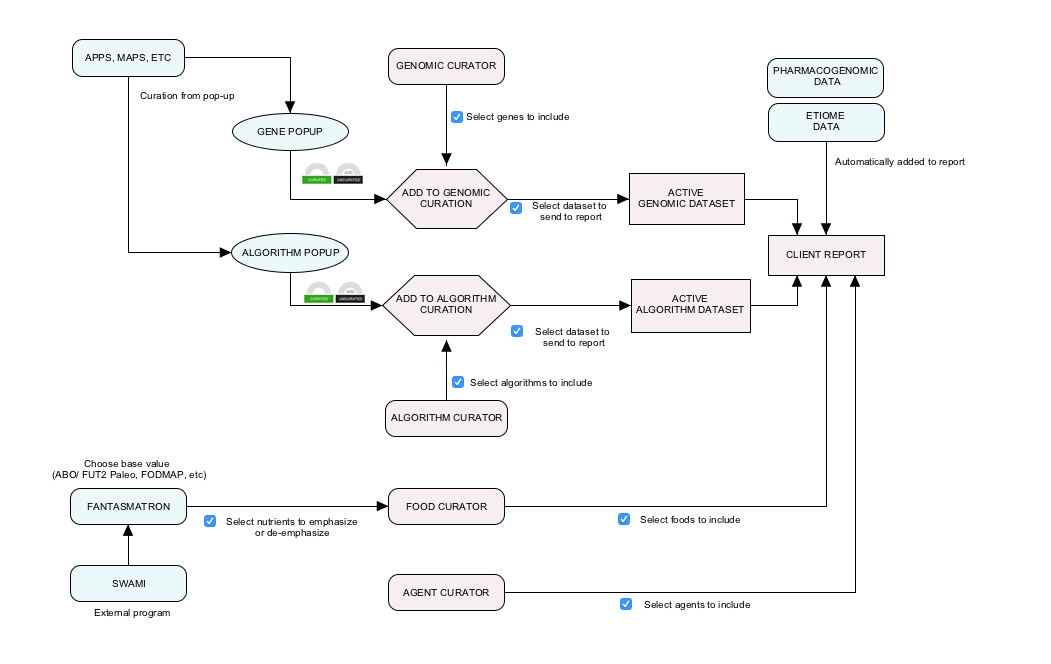| |  Help Docs
Workflow
Workflow in Opus 23 Pro
There is no specific 'right or wrong' way to structure your workflow in Opus 23 Pro. We've put this outline together as one way to do it that works for us:
Preliminaries:
Curation Period
- Run through the MAPPER maps
- Look for particularly stressed/ low functioning genes. Note / tag significant genes with either unique content or cut and paste text from gene info screen
- Launch ARGONAUT app
- Sort and filter by outcome and power factor identifying SNPS of interest. Note / tag significant SNPs with either unique content or cut and paste text from SNP info screen
- Launch LUMEN app
- Run through the LUMEN algorithms. Note/ tag significant algorithms with either unique content or cut and paste text from SNP info screen
- Launch WANDERER app
- Search and cross-reference significant SNPs and genes with Opus 23 Pro SNP data, GWAS data, algorithm results, pharmacogenomic interactions and natural product data
- Launch MOBOCASTER app
- Run through the MOBOCASTER scenarios. Note/ tag significant genes or SNP with either unique content or cut and paste text from SNP or gene info screens
- Launch DRUGGIE app
- Sort and filter by outcome and power factor identifying drugs of interest. Note / tag significant drugs with either unique content or cut and paste text from drug info screen
- Launch SUPERMOGADON app
- Sort and filter by outcome and power factor identifying pathology/ traits of interest. Note / tag significant pathology/ traits with either unique content or cut and paste text from PubMed info screen
- Launch GWASFED app
- Sort and filter by outcome and power factor identifying pathology/ traits of interest. Note / tag significant pathology/ traits (in particular disease/ traits with large effects and smaller frequencies) with either unique content or cut and paste text from PubMed info screen
- Launch FANTASMATRON app
- Adjust FANTASMATRON settings incorporating AI suggestions and adding others if warranted.
- Launch RARIFY app
- Check to see if any rare SNPs are homozygous for the rare alleles. Note/ Tag as necessary
- Optional:
- Launch PSYCHIC app to identify additional natural products to consider utilizing
 Report Period
Report Period
- Generate Chart Report
- Tag/ Note additional elements in each section
- Generate Client Report
Once you've gotten the hang of using Opus23 Pro, curation and reporting can be done can be in less than 30 minutes.
Notes on Consultations
We typically set aside 60 minutes for the genomic consult. We have discovered that working with the client from the computer screen is more effective than working with a printed report, although either is fine. In our clinic we've created a setup that has a small laptop that is used by the clinician and is plugged into a larger monitor that is viewed by the client.
Either way, work from the client report. Start at the top by discussing the most important elements you've notated. Then move onto the algorithms, syndromes and networks (if selected in the report options), GWAS data, pharmacogenomics, agents and foods. We've found that ending with a discussion of the selected the maps is effective at reinforcing what has been previously discussed.
One advantage of working from a computer is that you can easily switch back and forth between windows. One approach that we think is effective is to have the Client Report in one browser tab and the regular Opus 23 Interface in another. Besides being able to bring up the information pop-ups, this allows you to provide additional context, such as:
- When discussing a client's risk alleles for BCMO1 (beta-carotene oxygenase 1) you can bring up the SUPERMOGADON Manhattan plot for macular degeneration
- When discussion a client's CYP3A4 issues you can bring up the MOBOCASTER scenario for Phase I detoxification or the interactive MAPPER pathway map
Some final thoughts
Remember that any information you give to the client should be done in the context of genetic counseling, and appropriate support should be available to ensure they fully understand the implications of disease risk and potential benefit of interventions.
Make sure the client understands the basics of the probability. It will be distressing to the client to hear that they have double the risk of a certain disease if they are not also told that the disease itself has a low rate of occurrence. We like to remind the client that it can be unsettling to hear that they have double the risk of getting struck by lightning, unless they are also reminded that the base odds of getting hit by lightning are extremely low.
|

 Report Period
Report Period
